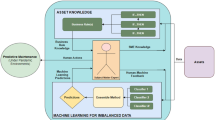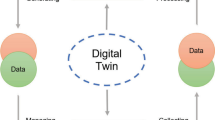Abstract
The rapid booming of information and communication technologies (ICT) and artificial intelligence has promoted the development of maintenance practices in the building industry towards a data-driven paradigm, of which the digital twin (DT) serves as the fundamental framework to strengthen data transit ability and interoperability. Among the state-of-the-art approaches in the maintenance industry, predictive maintenance (PdM) is a prominent approach by anticipating unexpected failures and unscheduled maintenance tasks. However, most current PdM frameworks are facility-specific, lacking generality and scalability. Besides, existing solutions mainly concentrate on condition monitoring and fault identification rather than failure prediction. Moreover, good prediction results rely heavily on sufficient labelled data sets, which are costly and labour-intensive to collect. To address these issues, the author developed a unified PdM framework for the building industry from the DT perspective. Next, a novel failure prediction method utilising the Semi-supervised Generative Adversarial Network (GAN) has been proposed in this article, which makes effective utilisation of both labelled and unlabelled data. Finally, an online platform has been developed to present the monitoring and prediction information. Experimental findings show the effectiveness and superiority of the proposed method for failure prediction through public data sets of building facilities.










Similar content being viewed by others
Data availability
The data sets generated during and/or analysed during the current study are available from the corresponding author on reasonable request.
References
Shi Z, O’Brien W (2019) Development and implementation of automated fault detection and diagnostics for building systems: a review. Autom Constr 104:215–229. https://doi.org/10.1016/j.autcon.2019.04.002
Jasiulewicz-Kaczmarek M, Legutko S, Kluk P (2020) Maintenance 4.0 technologies: new opportunities for sustainability driven maintenance. Manag Prod Eng Rev 11(2):74–87. https://doi.org/10.24425/mper.2020.133730
Hu W, Lim KYH, Yiyu Ca (2022) Digital twin and industry 4.0 enablers in building and construction: a survey. Build 12(11):1–27. https://doi.org/10.3390/buildings12112004
James M et al (2015) Unlocking the potential of the Internet of Things McKinsey & Company, Mckinsey, pp 1–4. http://www.mckinsey.com/business-functions/digital-mckinsey/our-insights/the-internet-of-things-the-value-of-digitizing-the-physical-world
Shalabi F, Turkan Y (2020) Bim-energy simulation approach for detecting building spaces with faults and problematic behavior. J Inf Technol Constr 25:342–360. https://doi.org/10.36680/J.ITCON.2020.020
Villa V, Naticchia B, Bruno G, Aliev K, Piantanida P, Antonelli D (2021) Iot open-source architecture for the maintenance of building facilities. Appl Sci 11(12):5374. https://doi.org/10.3390/app11125374
Cheng JCP, Chen W, Chen K, Wang Q (2020) Data-driven predictive maintenance planning framework for MEP components based on BIM and IoT using machine learning algorithms. Autom Constr 112:103087. https://doi.org/10.1016/j.autcon.2020.103087
Panfilov P (2018) 29th DAAAM International symposium on intelligent manufacturing and automation, 2018. In: Annals of DAAAM and proceedings of the international DAAAM Symposium, vol. 29(1). https://doi.org/10.2507/29th.daaam.proceedings.xxx
Bouabdallaoui Y, Lafhaj Z, Yim P, Ducoulombier L, Bennadji B (2021) Predictive maintenance in building facilities: a machine learning-based approach. Sensors 21(4):1–15. https://doi.org/10.3390/s21041044
Santiago AR, Antunes M, Barraca JP, Gomes D, Aguiar RL (2019) Predictive maintenance system for efficiency improvement of heating equipment. In: Proceedings—5th IEEE international conference big data serv application BigDataService 2019, work big data water resour environ hydraul eng work medical, heal Using big data Technology, pp 93–98. https://doi.org/10.1109/BigDataService.2019.00019
Razali MN et al (2021) Big data analytics for preventive maintenance management. Plan Malays. 19(3):423–437. https://doi.org/10.21837/PM.V19I17.1019
Chandra R et al (2020) A survey of failure mechanisms and statistics for critical electrical equipment in buildings. In: IECON 2020 the 46th annual conference of the IEEE industrial electronics society, pp 1955–1961.https://doi.org/10.1109/IECON43393.2020.9254225
Chen HM, Hou CC, Wang YH (2013) A 3D visualised expert system for maintenance and management of existing building facilities using reliability-based method. Expert Syst Appl 40(1):287–299. https://doi.org/10.1016/j.eswa.2012.07.045
Ahmed R, Zayed T, Nasiri F (2020) A hybrid genetic algorithm-based fuzzy Markovian model for the deterioration modeling of healthcare facilities. Algorithms 13(9):210. https://doi.org/10.3390/a13090210
Nzukam C, Sauter D, Voisin A, Levrat E (2019) Performances evaluation in view of predictive maintenance-a case study. In: 2019 4th conference on control and fault tolerant systems (SysTol), pp 226–231. https://doi.org/10.1109/SYSTOL.2019.8864798
Staino A, Abou-Eid R, Dersin P (2018) A Monte-Carlo approach for prognostics of clogging process in HVAC filters using a hybrid strategy: a real case study in railway systems. In: 2018 IEEE international conference on prognostics and health management (ICPHM), pp 1–8.https://doi.org/10.1109/ICPHM.2018.8448706
Yang C, Shen W, Chen Q, Gunay B (2018) A practical solution for HVAC prognostics: failure mode and effects analysis in building maintenance. J Build Eng 15:26–32. https://doi.org/10.1016/j.jobe.2017.10.013
Gálvez A, Diez-Olivan A, Seneviratne D, Galar D (2021) Fault detection and RUL estimation for railway HVAC systems using a hybrid model-based approach. Sustainability 13(12):6828. https://doi.org/10.3390/su13126828
Yang QP, Mesa-Jiménez JJ, Stokes L, Yang QP, Livina V (2021) Early warning signals of failures in building management systems. Int J Metrol Qual Eng 12:11. https://doi.org/10.1051/ijmqe/2021009
Candanedo IS, Nieves EH, González SR, Martín MTS, Briones AG (2018) Machine learning predictive model for industry 4.0. Commun Comput Inf Sci 877:501–510. https://doi.org/10.1007/978-3-319-95204-8_42
Yang C, Gunay B, Shi Z, Shen W (2021) Machine learning-based prognostics for central heating and cooling plant equipment health monitoring. IEEE Trans Autom Sci Eng 18(1):346–355. https://doi.org/10.1109/TASE.2020.2998586
Trivedi S, Bhola S, Talegaonkar A, Gaur P, Sharma S (2019) Predictive maintenance of air conditioning systems using supervised machine learning. In: 2019 20th international conference on intelligent system application to power systems (ISAP), pp 1–6. https://doi.org/10.1109/ISAP48318.2019.9065995
Li R, Pan S, Fang H, Xiong Y, Wang, F (2017) Fault prediction technology of civil aircraft based on Qar data. In: 2017 International conference on sensing, diagnostics, prognostics, and control SDPC, pp 468–472. https://doi.org/10.1109/SDPC.2017.94
Mishra KM, Huhtala K (2019) Elevator fault detection using profile extraction and deep autoencoder feature extraction for acceleration and magnetic signals. Appl Sci 9(15):2990. https://doi.org/10.3390/app9152990
Ma X, Chengkai L, Ng KH, Tan HP (2021) An internet of things-based lift predictive maintenance system. IEEE Potentials 40(1):17–23. https://doi.org/10.1109/MPOT.2020.2973697
Li LH, Lai CY, Kuo FH, Chai PY (2019) Predictive maintenance of vertical lift storage motor based on machine learning. Int J Appl Sci Eng 16(2):109–118. https://doi.org/10.6703/IJASE.201909_16(2).109
Quek YT, Woo WL, Thillainathan L (2020) IoT load classification and anomaly warning in ELV Dc picogrids using hierarchical extended k–nearest neighbors. IEEE Internet Things J 7(2):863–873. https://doi.org/10.1109/JIOT.2019.2945425
Assaf S, Srour I (2021) Using a data driven neural network approach to forecast building occupant complaints. Build Environ 200:107972. https://doi.org/10.1016/j.buildenv.2021.107972
Ferrández-Pastor FJ, García-Chamizo JM, Gomez-Trillo S, Valdivieso-Sarabia R, Nieto-Hidalgo M (2019) Smart management consumption in renewable energy fed ecosystems. Sensors 19(13):1–28. https://doi.org/10.3390/s19132967
Gouda Mohamed A, Marzouk M (2021) Building condition assessment using artificial neural network and structural equations. Expert Syst Appl 186:115743. https://doi.org/10.1016/j.eswa.2021.115743
Ahmed R, Nasiri F, Zayed T (2022) Two-stage predictive maintenance planning for hospital buildings: a multiple-objective optimization-based clustering approach. J Perform Constr Facil 36(1):1–11. https://doi.org/10.1061/(asce)cf.1943-5509.0001691
Ahmed R, Nasiri F, Zayed T (2021) A novel neutrosophic-based machine learning approach for maintenance prioritisation in healthcare facilities. J Build Eng 42:102480. https://doi.org/10.1016/j.jobe.2021.102480
Peiris S, De Silva N (2021) A fuzzy-logic model for benchmarking concrete roof maintenance. Facilities 39(7/8):568–583. https://doi.org/10.1108/F-03-2020-0026
Hosamo HH, Svennevig PR, Svidt K, Han D, Nielsen HK (2022) A digital twin predictive maintenance framework of air handling units based on automatic fault detection and diagnostics. Energy Build 261:111988. https://doi.org/10.1016/j.enbuild.2022.111988
Liu B, Zhang Y, Zhang G, Zheng P (2019) Edge-cloud orchestration driven industrial smart product-service systems solution design based on CPS and IIoT. Adv Eng Inform 42:100984. https://doi.org/10.1016/j.aei.2019.100984
Yan K, Huang J, Shen W, Ji Z (2020) Unsupervised learning for fault detection and diagnosis of air handling units. Energy Build 210:109689. https://doi.org/10.1016/j.enbuild.2019.109689
Granderson J, Lin G, Harding A, Im P, Chen Y (2020) Building fault detection data to aid diagnostic algorithm creation and performance testing. Sci Data 7(1):1–14. https://doi.org/10.1038/s41597-020-0398-6
Li B, Cheng F, Cai H, Zhang X, Cai W (2021) A Semi-supervised approach to fault detection and diagnosis for building HVAC systems based on the modified generative adversarial network. Energy Build 246:111044. https://doi.org/10.1016/j.enbuild.2021.111044
Gamil Y, Abdullah MA, Abd Rahman I, Asad MM (2020) Internet of things in construction industry revolution 4.0: recent trends and challenges in the malaysian context. J Eng Des Tech 18(5):1091–1102
Acknowledgements
This research did not receive any specific grant from funding agencies in the public, commercial, or not-for-profit sectors. The authors would like to acknowledge the professional advice of Bingxu Li from the Nanyang Technological University.
Author information
Authors and Affiliations
Corresponding author
Ethics declarations
Conflict of interest
The authors declare that they have no known competing financial interests or personal relationships that could have appeared to influence the work reported in this paper.
Additional information
Publisher's Note
Springer Nature remains neutral with regard to jurisdictional claims in published maps and institutional affiliations.
Rights and permissions
Springer Nature or its licensor (e.g. a society or other partner) holds exclusive rights to this article under a publishing agreement with the author(s) or other rightsholder(s); author self-archiving of the accepted manuscript version of this article is solely governed by the terms of such publishing agreement and applicable law.
About this article
Cite this article
Hu, W., Cai, Y. A semi-supervised method for digital twin-enabled predictive maintenance in the building industry. Neural Comput & Applic (2024). https://doi.org/10.1007/s00521-024-09926-1
Received:
Accepted:
Published:
DOI: https://doi.org/10.1007/s00521-024-09926-1




